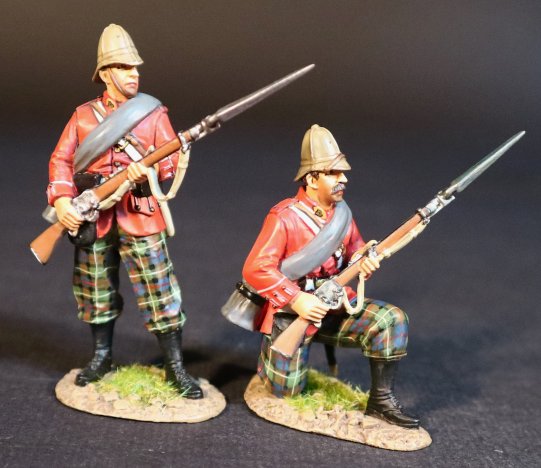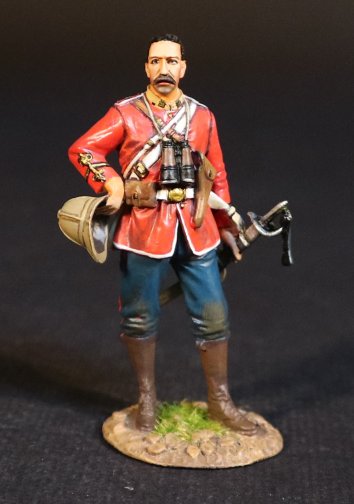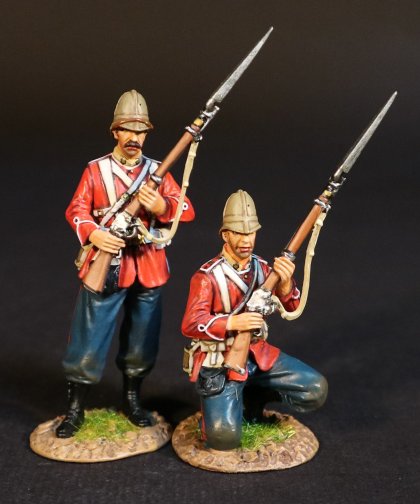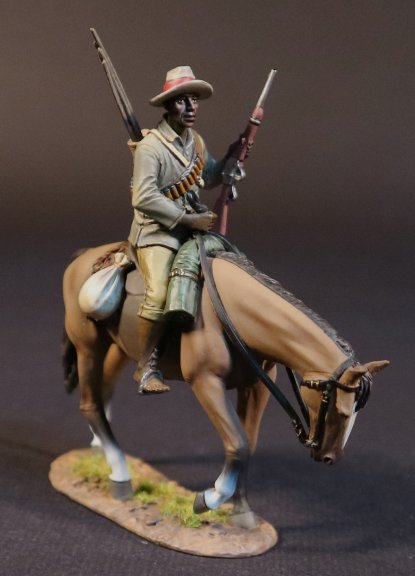- Joined
- Feb 2, 2011
- Messages
- 2,379
THE ANGLO ZULU WAR
THE BATTLE OF GINGINDHLOVU, 2nd APRIL 1879.
The Battle of Gingindhlovu was fought on 2nd April 1879 between a British relief column sent to break the siege at Eshowe, and a Zulu impi of king Cetshwayo.
The British soldier would refer to it as the Battle of “GIN GIN I LOVE YOU”.
Charles Pearson had led No.1 column of the British invasion force across the Tugela River to establish an advanced base at Eshowe. Having set up a base at a deserted Norwegian mission station, the British found themselves besieged.
A relief column was organized by Lord Chelmsford and departed Fort Tenedos on 29th March to relieve the garrison.
Chelmsford’s relief force comprised 3,390 Europeans, and 2,280 Africans.
Lord Chelmsford ensured his men spent much time laagering and entrenching their camp at the end of each day, and kept ammunition boxes open and at the ready.
Although this was slow progress, Pearson’s observers at Eshowe were able to see the relief column entrenched on the south bank of the Neyzane, on the evening of the 1st April.
The Zulu impi was composed of 12,000 warriors, some of whom were Isandlwana veterans drawn from regiments in the main Zulu army, while the remainder were warriors who lived in the vicinity of Eshowe.
Many of the Zulu commanders wanted to attack the relief column that night, but Prince Dabulamanzi KaMpande, who was half brother to king Cetshwayo and commander of the impi’s right wing, convinced them to wait until morning.
At dawn on 2 April 1879, the morning sun revealed muddy ground and a heavy mist. Chelmsford had decided after hearing Dunn's report to not continue on toward Eshowe early the next morning. Instead, he would deploy units of the Natal Native Contingent to feel for the Zulus. As the NNC were preparing to advance shots were heard from the night pickets still on duty. The impi was advancing; the main force split into two columns before crossing the Ineyzane and assuming the "chest and horns" formation. The left horn sharply curved to the right to assault the laager's north-east corner, while the "chest" gently curved toward the north face of the laager.
Another force passed Misi Hill and approached the laager, forming the impi’s right horn.
The buffalo formation came in at a run on the three sides of the laager as Chelmsford had wanted; at a range of 300–400 yd (270–370 m) the British infantry opened fire, supported by the Gatling guns and rockets.
Zulu marksmen caused a few casualties within the laager, but the defenders kept the Zulus at bay.
Although the Zulu regiments made persistent rushes to get within stabbing range, their charges lacked the drive and spirit that had pushed them forward at Isandlwana and Rorke’s Drift.
The only zulu to reach the laager was a ten year old boy, who was immediately taken prisoner by members of the naval brigade and later served as a kind of mascot on their ship, Boadicea.
Around 7am, the main impi attack had been halted. Chelmsford ordered his mounted troops to attack, followed by the NNC.
Many zulu were killed as they withdrew.
Chelmsford had begun to avenge the Imperial dead of Isandlwana, but for the present he was content to relieve Pearson and return to Natal.
THE 91st (PRINCESS LOUISE’S ARGYLLSHIRE) HIGHLANDERS
The 91st Highlanders were stationed at Aldershot when they received an order, on 12th February 1879 to proceed on active service to Natal. The regiment formed the advance guard on the Eshowe relief column.
During the Battle of Gingindlovu the 91st held the (Southern) rear face of the lager and bore the brunt of the second attack.
After the relief of Eschowe the regiment was employed on convoy duty until it was attached to the 2nd Brigade of Crealock’s 1st Division for the second invasion of Zululand.

The 91st was the only Highland regiment involved in the 1879 Zulu War, and photographs taken at the time show the regiment wearing greatcoats/blankets in bandolier-fashion (en banderole) over the left shoulder, and tartan trousers, with only the pipers in kilts.

GG91-15
THE ANGLO ZULU WAR
THE BATTLE OF GINGINDHLOVU, 2nd APRIL 1879,
THE ESHOWE RELIEF COLUMN,
91st REGIMENT (PRINCESS LOUISE’S ARGYLLSHIRE HIGHLANDERS)
2 HIGHLANDERS

GG91-15N
THE ANGLO ZULU WAR
THE BATTLE OF GINGINDHLOVU, 2nd APRIL 1879,
THE ESHOWE RELIEF COLUMN,
91st REGIMENT (PRINCESS LOUISE’S ARGYLLSHIRE HIGHLANDERS)
4 HIGHLANDERS
THE 2nd BATTALION, 3rd (EAST KENT) REGIMENT (THE BUFFS)
Towards the end of 1878, the headquarters and five companies of the Buffs, which had been scattered over a wide area of Natal, were ordered to concentrate at Thring’s Post, near the mouth of the Tugela river.
Early in November three more companies arrived from Mauritius, at which time they were ordered to construct an earthwork on the right bank of the river, near the mouth, which subsequently became known as Fort Pearson, after the commander of the first column of the field force.
From 4-12 January 1879, the Buffs assisted the Naval Brigade in completing the arrangements for the crossing of Pearson’s column, of which they formed part.
Two companies of the 2nd Battalion, 3rd Regiment were part of the 1st Brigade of the Eshowe relief column, and defended part of the west face of the laager alongside the five companies of the 99th Regiment.

The regiment was stationed in Ceylon when in February 1879, it received orders to proceed to Natal. On its journey it joined the 1st Brigade of the column that was being formed for the relief of Eshowe.
They held the right flank face of the laager at Gingindhlovu and assisted in repelling the first enemy attack.
During the second invasion of Zululand they were in the 2nd Brigade of Crealock’s 1st Division.

GG03-01
THE ANGLO ZULU WAR
THE BATTLE OF GINGINDHLOVU, 2nd APRIL 1879,
THE ESHOWE RELIEF COLUMN,
THE 2nd BATTALION, 3rd (EAST KENT) REGIMENT (THE BUFFS),
OFFICER

GG03-03
THE ANGLO ZULU WAR
THE BATTLE OF GINGINDHLOVU, 2nd APRIL 1879,
THE ESHOWE RELIEF COLUMN,
THE 2nd BATTALION, 3rd (EAST KENT) REGIMENT (THE BUFFS)

GG03-03N
THE ANGLO ZULU WAR
THE BATTLE OF GINGINDHLOVU, 2nd APRIL 1879,
THE ESHOWE RELIEF COLUMN,
THE 2nd BATTALION, 3rd (EAST KENT) REGIMENT (THE BUFFS)
NATAL NATIVE HORSE
The Natal Native Horse was formed in 1879, from Natal Bantu, and they rode their own ponies and served as scouts and transport men.
The ranks were mainly filled by Christians from the Edendale and Dreifontein Missions.
Three of the troops were drawn from the amaNgwane clan, who lived in the Drakensburg foothills in Natal, and were old enemies of the Zulus.
All of the NNH wore European clothing and had a red rag round their hats. Most preferred to ride barefoot, with their toes grasping the stirrup, but the Edendale men were booted and spurred.
All were armed with carbines, and some carried hide quivers of assegais.
There were five troops of Natal Native Horse at Isandhlwana, all under Captain W. Barton, and from contemporary accounts they did their work particularly well. At Isandhlwana they fought their way through the encircling Zulus and lined the far bank of the Buffalo river to cover the flight of the survivors.
If well led and intelligently employed, the Natal Native Horse excelled at their primary duties of scouting and mopping up after a battle.
They were never intended as a front line force.
At Gingindhlovu there was 1 troop of Natal Native Horse present, along with Jantzi’s Native Horse which were also part of the Natal Native Horse.
Mafunzi’s Mounted Natives, was also a mounted unit, raised in 1879 with a strength of 73 men. They were to serve with the 1st Division during the Zulu War.

GGNNH-02
THE ANGLO ZULU WAR
THE BATTLE OF GINGINDHLOVU, 2nd APRIL 1879,
THE ESHOWE RELIEF COLUMN,
NATAL NATIVE HORSE
THE BATTLE OF GINGINDHLOVU, 2nd APRIL 1879.
The Battle of Gingindhlovu was fought on 2nd April 1879 between a British relief column sent to break the siege at Eshowe, and a Zulu impi of king Cetshwayo.
The British soldier would refer to it as the Battle of “GIN GIN I LOVE YOU”.
Charles Pearson had led No.1 column of the British invasion force across the Tugela River to establish an advanced base at Eshowe. Having set up a base at a deserted Norwegian mission station, the British found themselves besieged.
A relief column was organized by Lord Chelmsford and departed Fort Tenedos on 29th March to relieve the garrison.
Chelmsford’s relief force comprised 3,390 Europeans, and 2,280 Africans.
Lord Chelmsford ensured his men spent much time laagering and entrenching their camp at the end of each day, and kept ammunition boxes open and at the ready.
Although this was slow progress, Pearson’s observers at Eshowe were able to see the relief column entrenched on the south bank of the Neyzane, on the evening of the 1st April.
The Zulu impi was composed of 12,000 warriors, some of whom were Isandlwana veterans drawn from regiments in the main Zulu army, while the remainder were warriors who lived in the vicinity of Eshowe.
Many of the Zulu commanders wanted to attack the relief column that night, but Prince Dabulamanzi KaMpande, who was half brother to king Cetshwayo and commander of the impi’s right wing, convinced them to wait until morning.
At dawn on 2 April 1879, the morning sun revealed muddy ground and a heavy mist. Chelmsford had decided after hearing Dunn's report to not continue on toward Eshowe early the next morning. Instead, he would deploy units of the Natal Native Contingent to feel for the Zulus. As the NNC were preparing to advance shots were heard from the night pickets still on duty. The impi was advancing; the main force split into two columns before crossing the Ineyzane and assuming the "chest and horns" formation. The left horn sharply curved to the right to assault the laager's north-east corner, while the "chest" gently curved toward the north face of the laager.
Another force passed Misi Hill and approached the laager, forming the impi’s right horn.
The buffalo formation came in at a run on the three sides of the laager as Chelmsford had wanted; at a range of 300–400 yd (270–370 m) the British infantry opened fire, supported by the Gatling guns and rockets.
Zulu marksmen caused a few casualties within the laager, but the defenders kept the Zulus at bay.
Although the Zulu regiments made persistent rushes to get within stabbing range, their charges lacked the drive and spirit that had pushed them forward at Isandlwana and Rorke’s Drift.
The only zulu to reach the laager was a ten year old boy, who was immediately taken prisoner by members of the naval brigade and later served as a kind of mascot on their ship, Boadicea.
Around 7am, the main impi attack had been halted. Chelmsford ordered his mounted troops to attack, followed by the NNC.
Many zulu were killed as they withdrew.
Chelmsford had begun to avenge the Imperial dead of Isandlwana, but for the present he was content to relieve Pearson and return to Natal.
THE 91st (PRINCESS LOUISE’S ARGYLLSHIRE) HIGHLANDERS
The 91st Highlanders were stationed at Aldershot when they received an order, on 12th February 1879 to proceed on active service to Natal. The regiment formed the advance guard on the Eshowe relief column.
During the Battle of Gingindlovu the 91st held the (Southern) rear face of the lager and bore the brunt of the second attack.
After the relief of Eschowe the regiment was employed on convoy duty until it was attached to the 2nd Brigade of Crealock’s 1st Division for the second invasion of Zululand.

The 91st was the only Highland regiment involved in the 1879 Zulu War, and photographs taken at the time show the regiment wearing greatcoats/blankets in bandolier-fashion (en banderole) over the left shoulder, and tartan trousers, with only the pipers in kilts.

GG91-15
THE ANGLO ZULU WAR
THE BATTLE OF GINGINDHLOVU, 2nd APRIL 1879,
THE ESHOWE RELIEF COLUMN,
91st REGIMENT (PRINCESS LOUISE’S ARGYLLSHIRE HIGHLANDERS)
2 HIGHLANDERS

GG91-15N
THE ANGLO ZULU WAR
THE BATTLE OF GINGINDHLOVU, 2nd APRIL 1879,
THE ESHOWE RELIEF COLUMN,
91st REGIMENT (PRINCESS LOUISE’S ARGYLLSHIRE HIGHLANDERS)
4 HIGHLANDERS
THE 2nd BATTALION, 3rd (EAST KENT) REGIMENT (THE BUFFS)
Towards the end of 1878, the headquarters and five companies of the Buffs, which had been scattered over a wide area of Natal, were ordered to concentrate at Thring’s Post, near the mouth of the Tugela river.
Early in November three more companies arrived from Mauritius, at which time they were ordered to construct an earthwork on the right bank of the river, near the mouth, which subsequently became known as Fort Pearson, after the commander of the first column of the field force.
From 4-12 January 1879, the Buffs assisted the Naval Brigade in completing the arrangements for the crossing of Pearson’s column, of which they formed part.
Two companies of the 2nd Battalion, 3rd Regiment were part of the 1st Brigade of the Eshowe relief column, and defended part of the west face of the laager alongside the five companies of the 99th Regiment.

The regiment was stationed in Ceylon when in February 1879, it received orders to proceed to Natal. On its journey it joined the 1st Brigade of the column that was being formed for the relief of Eshowe.
They held the right flank face of the laager at Gingindhlovu and assisted in repelling the first enemy attack.
During the second invasion of Zululand they were in the 2nd Brigade of Crealock’s 1st Division.

GG03-01
THE ANGLO ZULU WAR
THE BATTLE OF GINGINDHLOVU, 2nd APRIL 1879,
THE ESHOWE RELIEF COLUMN,
THE 2nd BATTALION, 3rd (EAST KENT) REGIMENT (THE BUFFS),
OFFICER

GG03-03
THE ANGLO ZULU WAR
THE BATTLE OF GINGINDHLOVU, 2nd APRIL 1879,
THE ESHOWE RELIEF COLUMN,
THE 2nd BATTALION, 3rd (EAST KENT) REGIMENT (THE BUFFS)

GG03-03N
THE ANGLO ZULU WAR
THE BATTLE OF GINGINDHLOVU, 2nd APRIL 1879,
THE ESHOWE RELIEF COLUMN,
THE 2nd BATTALION, 3rd (EAST KENT) REGIMENT (THE BUFFS)
NATAL NATIVE HORSE
The Natal Native Horse was formed in 1879, from Natal Bantu, and they rode their own ponies and served as scouts and transport men.
The ranks were mainly filled by Christians from the Edendale and Dreifontein Missions.
Three of the troops were drawn from the amaNgwane clan, who lived in the Drakensburg foothills in Natal, and were old enemies of the Zulus.
All of the NNH wore European clothing and had a red rag round their hats. Most preferred to ride barefoot, with their toes grasping the stirrup, but the Edendale men were booted and spurred.
All were armed with carbines, and some carried hide quivers of assegais.
There were five troops of Natal Native Horse at Isandhlwana, all under Captain W. Barton, and from contemporary accounts they did their work particularly well. At Isandhlwana they fought their way through the encircling Zulus and lined the far bank of the Buffalo river to cover the flight of the survivors.
If well led and intelligently employed, the Natal Native Horse excelled at their primary duties of scouting and mopping up after a battle.
They were never intended as a front line force.
At Gingindhlovu there was 1 troop of Natal Native Horse present, along with Jantzi’s Native Horse which were also part of the Natal Native Horse.
Mafunzi’s Mounted Natives, was also a mounted unit, raised in 1879 with a strength of 73 men. They were to serve with the 1st Division during the Zulu War.

GGNNH-02
THE ANGLO ZULU WAR
THE BATTLE OF GINGINDHLOVU, 2nd APRIL 1879,
THE ESHOWE RELIEF COLUMN,
NATAL NATIVE HORSE

